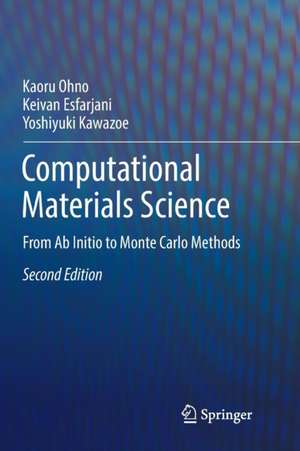Computational Materials Science: From Ab Initio to Monte Carlo Methods
Autor Kaoru Ohno, Keivan Esfarjani, Yoshiyuki Kawazoeen Limba Engleză Paperback – feb 2019
This second edition includes a lot of recent theoretical techniques in materials research. With the computers power now available, it is possible to use these numerical techniques to study various physical and chemical properties of complex materials from first principles. The new edition also covers empirical methods, such as tight-binding and molecular dynamics.
| Toate formatele și edițiile | Preț | Express |
|---|---|---|
| Paperback (2) | 590.95 lei 6-8 săpt. | |
| Springer Berlin, Heidelberg – feb 2019 | 590.95 lei 6-8 săpt. | |
| Springer Berlin, Heidelberg – 23 sep 2011 | 642.68 lei 6-8 săpt. | |
| Hardback (1) | 693.90 lei 3-5 săpt. | +31.92 lei 4-10 zile |
| Springer Berlin, Heidelberg – 23 apr 2018 | 693.90 lei 3-5 săpt. | +31.92 lei 4-10 zile |
Preț: 590.95 lei
Preț vechi: 695.24 lei
-15% Nou
113.11€ • 122.91$ • 95.08£
Carte tipărită la comandă
Livrare economică 21 aprilie-05 mai
Specificații
ISBN-10: 3662585871
Pagini: 427
Ilustrații: XII, 427 p.
Dimensiuni: 155 x 235 mm
Greutate: 0.61 kg
Ediția:Softcover reprint of the original 2nd ed. 2018
Editura: Springer Berlin, Heidelberg
Colecția Springer
Locul publicării:Berlin, Heidelberg, Germany
Cuprins
Notă biografică
Dr. Ohno is a Professor in Yokohama National University, who is working in the field of computational materials science and physics. His Doctor thesis at Tohoku University was "Critical Phenomena at Surfaces" using the renormalization group theory and the high-temperature expansion. After he became Assistant Professor of Tohoku University, he started Monte Carlo simulation on star-polymers with the collaboration with Prof. Kurt Binder.
Four years later, he became Associate Professor of IMR, Tohoku University, and started implementation of the ab initio all-electron code named TOMBO with Prof. Kawazoe. Now TOMBO can do the self-consistent GWΓ calculation, which is the first achievement in the world. His experience in developing this code strongly reflects this book and many detailed explanations and discussions are given in this book. He is doing not only ab initio calculations but also first-principles mappings onto the lattice models. His idea of the potential renormalization theory is the very promising method to map the ab initio results onto the lattice gas models, and now expected a wide application to various materials research subjects.
Dr. Esfarjani is a computational materials scientist with interest in solid-state energy conversion and storage, transport phenomena and thermoelectric materials. He is the leading expert in modeling and computation of thermal transport properties of materials. He was one of the pioneers in introducing the first-principles approach to compute phonon relaxation rates and deduce the thermal conductivity from solving the Boltzmann transport equation for phonons. His work on silicon showed for the first time the wide distribution of phonon mean free paths, previously assumed as narrow. He has also extended this approach to treat the effect of electron-phonon interactions on thermal conductivity of doped semiconductors. His other research has focused on properties of carbon nanotubes and fullerenes, cross-plane thermionic transport in 2d layered materials, and cluster formation and stability.Dr. Esfarjani is presently a professor in the mechanical engineering department of the University of Virginia. He obtained his PhD in condensed matter theory at the University of Delaware. This was followed by a postdoctoral research at Washington University in St. Louis, before he moved to Japan and started his career in materials science at the Institute for Materials Research of the Tohoku University, where he was assistant and then associate professor. This was followed by appointments at the Sharif University of Technology, University of California Santa Cruz, Massachussets Institute of Technology and Rutgers University, before finally joining the faculty of University of Virginia.
Textul de pe ultima copertă
This second edition includes a lot of recent theoretical techniques in materials research. With the computers power now available, it is possible to use these numerical techniques to study various physical and chemical properties of complex materials from first principles. The new edition also covers empirical methods, such as tight-binding and molecular dynamics.
Caracteristici
Descriere
This textbook introduces modern techniques based on computer simulation to study materials science. It starts from first principles calculations enabling to calculate the physical and chemical properties by solving a many-body Schroedinger equation with Coulomb forces. For the exchange-correlation term, the local density approximation is usually applied. After the introduction of the first principles treatment, tight-binding and classical potential methods are briefly introduced to indicate how one can increase the number of atoms in the system. In the second half of the book, Monte Carlo simulation is discussed in detail. Problems and solutions are provided to facilitate understanding. Readers will gain sufficient knowledge to begin theoretical studies in modern materials research.
This second edition includes a lot of recent theoretical techniques in materials research. With the computers power now available, it is possible to use these numerical techniques to study various physical and chemical properties of complex materials from first principles. The new edition also covers empirical methods, such as tight-binding and molecular dynamics.
